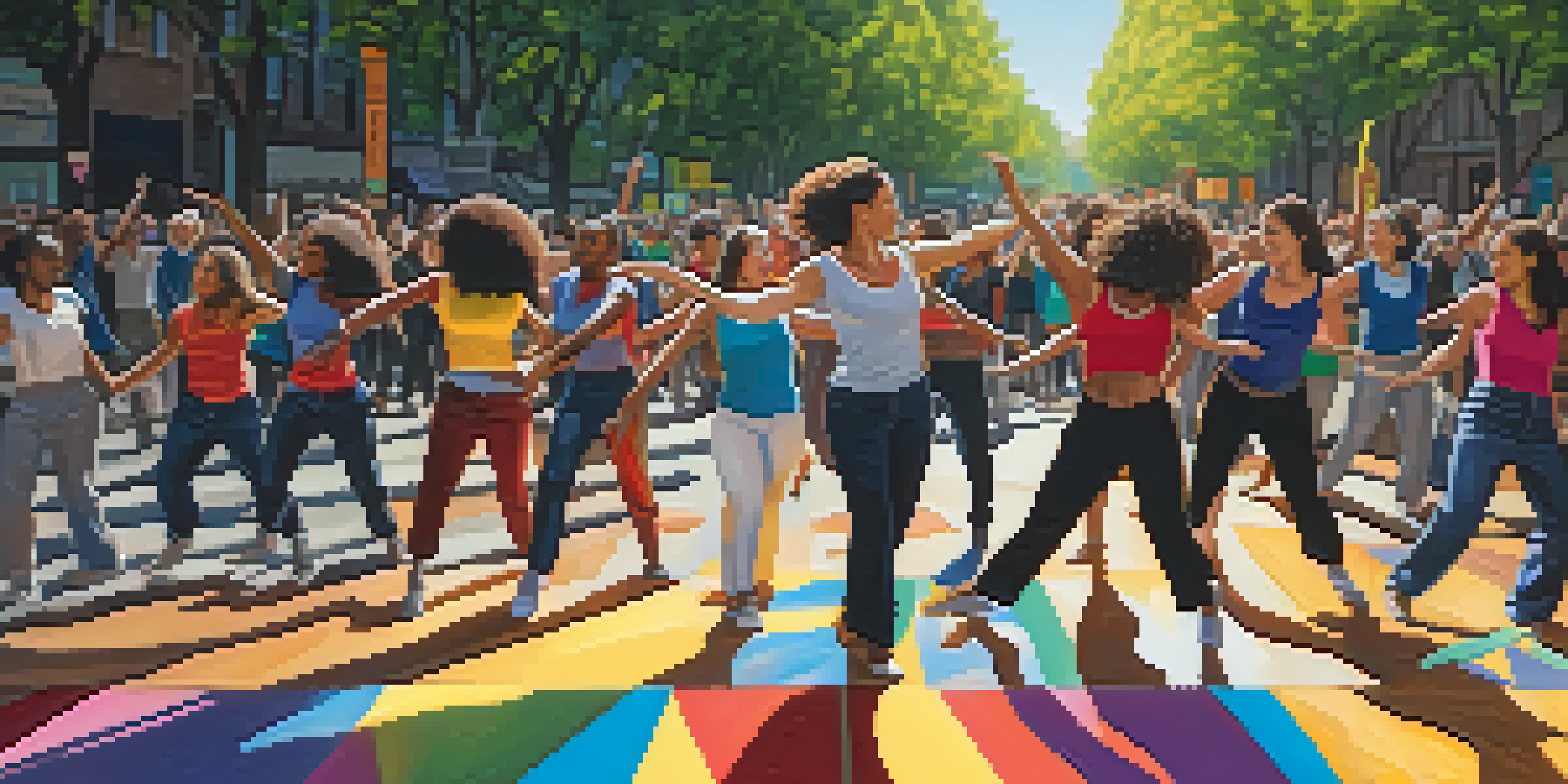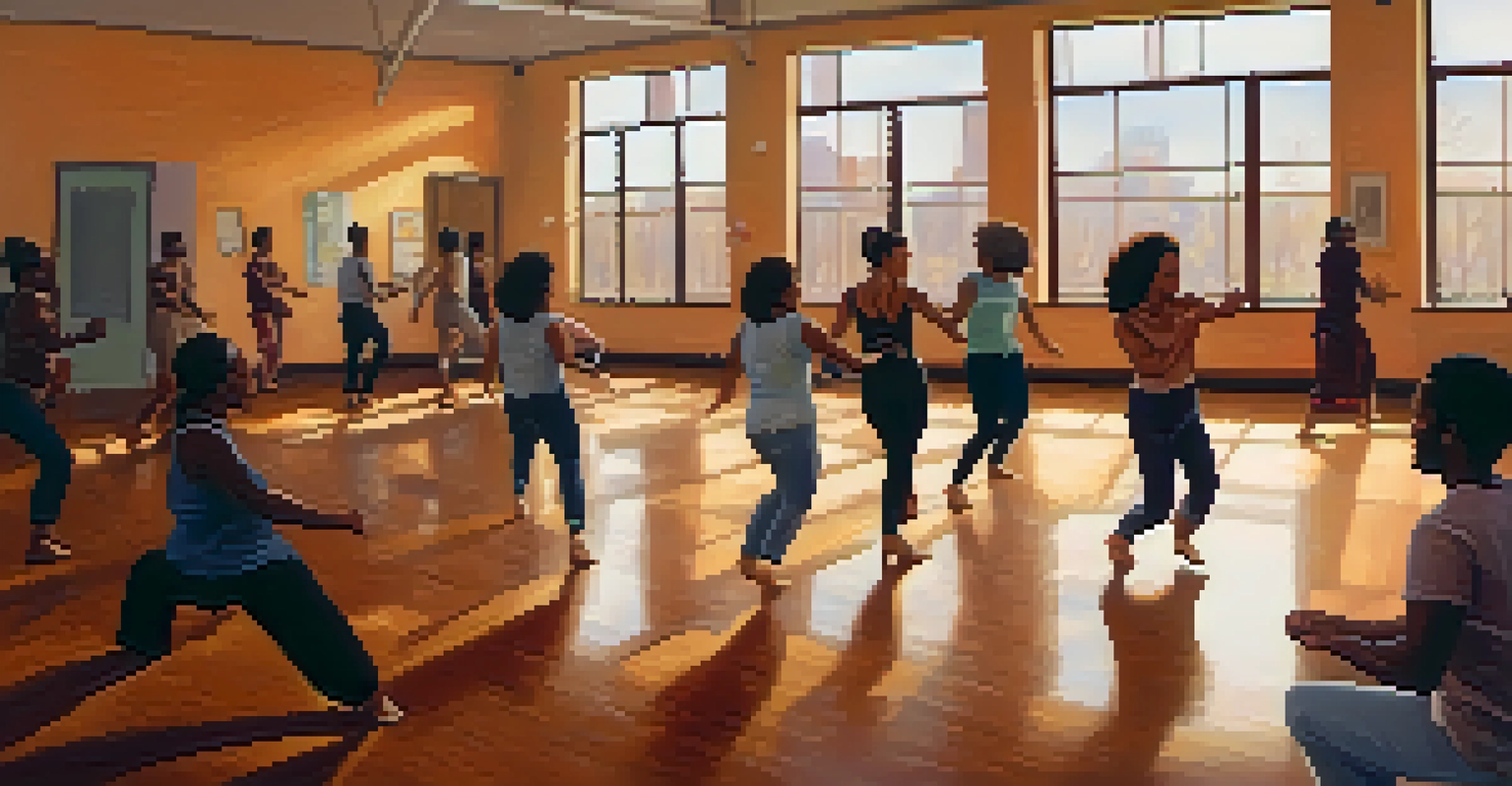Dance and Social Change: Movements Through Movement

The Historical Role of Dance in Social Movements
Dance has long been intertwined with social movements, serving as a powerful form of expression. From the Civil Rights Movement to the Women's Suffrage Movement, dance has provided a vibrant medium for people to communicate their struggles and aspirations. It unites individuals, fostering a sense of community and shared purpose through rhythm and movement.
Dance is the hidden language of the soul.
For example, during the Civil Rights Movement, the freedom songs and dances played a crucial role in rallying support and spreading messages of hope. These performances not only entertained but also educated audiences about the fight for equality. By embodying the spirit of resistance, dancers became catalysts for social change.
Related Resource
Moreover, dance allows for the exploration of complex social issues in an accessible way. Whether through traditional forms or contemporary styles, movements can convey powerful narratives that provoke thought and inspire action, making dance an essential component of societal transformation.
Dance as a Form of Protest
In recent years, dance has emerged as a compelling form of protest, drawing attention to various social issues. From flash mobs to choreographed demonstrations, these creative expressions bring visibility to causes like climate change, racial injustice, and gender equality. Through coordinated movements, dancers challenge the status quo and demand change.

Take, for instance, the viral success of the 'Dance for Justice' movement, where dancers perform on the streets to raise awareness about police brutality. These performances not only captivate audiences but also invite them to engage in important conversations about justice and reform. The rhythm of the dance acts as a heartbeat for the movement, pulsating with energy and urgency.
Dance Unifies Social Movements
Throughout history, dance has served as a powerful medium for expression and community building in various social movements.
Ultimately, dance as protest transcends language barriers, creating a universal dialogue about pressing issues. It empowers individuals to express their frustrations and hopes, reminding us that movement can be a potent force for change.
Cultural Significance of Dance in Communities
Dance is deeply rooted in culture, serving as a reflection of a community's identity and values. Through folk dances, traditional performances, and contemporary styles, communities express their unique histories and experiences. This cultural significance often extends beyond entertainment, playing a role in uniting people in times of struggle and joy.
The dance is a poem of which each movement is a word.
For example, indigenous dance forms often carry stories and teachings passed down through generations. These dances are not merely performances; they are vital expressions of cultural heritage and resilience. By preserving these traditions, communities strengthen their bonds and assert their presence in the face of social challenges.
Related Resource
Moreover, dance can facilitate cross-cultural exchanges, fostering understanding and empathy among diverse groups. When people come together to share their dances, they not only celebrate their differences but also find common ground, paving the way for social cohesion and mutual respect.
Dance in the Digital Age: A New Frontier
The rise of social media has transformed how dance is used as a tool for social change, allowing movements to reach a global audience. Platforms like TikTok and Instagram have given dancers a stage to showcase their art while raising awareness about important issues. This digital landscape amplifies voices that may have otherwise gone unheard.
For instance, the #BlackLivesMatter movement saw dancers using their platforms to create impactful choreography that highlighted the fight against systemic racism. These videos not only spread awareness but also inspired others to join the movement, highlighting the power of dance in a modern context. The combination of creativity and activism becomes a viral force for change.
Digital Age Amplifies Dance Activism
Social media platforms have transformed dance into a global tool for social change, allowing voices to be heard and movements to gain momentum.
As we navigate this digital age, the relationship between dance and social change continues to evolve. The accessibility of platforms allows for a diverse range of voices and styles, making it easier than ever for individuals to contribute to the narrative of social justice through movement.
The Therapeutic Power of Dance in Activism
Beyond its role in protest, dance serves as a therapeutic outlet for those involved in social movements. The act of dancing can provide relief from stress, anxiety, and trauma, which are often experienced by activists fighting for change. This therapeutic aspect can rejuvenate spirits and foster resilience among those who are often at the forefront of social struggles.
For instance, dance therapy programs have been implemented in communities affected by violence and oppression, allowing participants to express their emotions through movement. These sessions not only promote healing but also encourage participants to reconnect with their bodies and find strength within themselves. This renewed sense of self can be invaluable in sustaining long-term activism.
Related Resource
Ultimately, the therapeutic power of dance reinforces the idea that social change is not just about external actions but also internal well-being. By prioritizing mental and emotional health, activists can continue their important work with renewed passion and purpose.
Intersectionality: Dance and Diverse Voices
Intersectionality highlights the interconnected nature of social categorizations, such as race, gender, and class. In the world of dance, this concept is essential as it allows for the representation of diverse voices and experiences. Dancers from varying backgrounds often share their unique stories through movement, enriching the tapestry of social change.
For example, the emergence of dancers challenging traditional norms around gender and sexuality has sparked conversations about inclusivity in the dance community. These artists use their performances to advocate for LGBTQ+ rights and representation, demonstrating the power of dance as a platform for diverse narratives. By embracing intersectionality, the dance community can cultivate a more inclusive environment that celebrates all identities.
Therapeutic Benefits for Activists
Dance not only acts as a form of protest but also provides therapeutic relief for activists, promoting mental and emotional well-being.
This blending of voices not only strengthens the movement for social change but also fosters a sense of solidarity among marginalized groups. When dancers unite to share their stories, they create a powerful chorus of change that resonates far beyond the stage.
The Future of Dance and Social Change
As we look to the future, the relationship between dance and social change is poised to grow even stronger. With increasing awareness of social issues, dancers are likely to continue using their art as a means of advocacy and expression. The next generation of artists will shape the dialogue around important topics, ensuring that the movement for change remains dynamic and relevant.
Moreover, collaborations between dancers and other activists can amplify efforts to address pressing social concerns. By joining forces with musicians, visual artists, and community leaders, dancers can create multi-dimensional projects that resonate with wider audiences. These collaborative efforts can inspire innovative approaches to activism, pushing the boundaries of what dance can achieve.

In essence, the future of dance in the realm of social change is bright and filled with potential. As long as there are stories to tell and movements to inspire, dance will continue to be a vital force for progress in society.